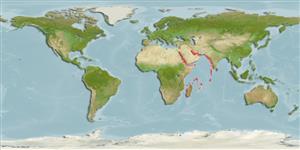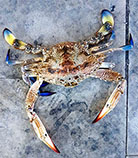Portunus segnis (Forskål, 1775)
| Native range | All suitable habitat | Point map | Year 2050 |

|
| This map was computer-generated and has not yet been reviewed. |
| Portunus segnis AquaMaps Data sources: GBIF OBIS |
Classification / Names Common names | Synonyms | CoL | ITIS | WoRMS
Malacostraca | Decapoda | Portunidae
Environment: milieu / climate zone / depth range / distribution range Ecology
Benthic; depth range 0 - 65 m (Ref. 106819). Tropical
Distribution Countries | FAO areas | Ecosystems | Occurrences | Introductions
Western Indian Ocean: From Pakistan westwards to the Arabian Gulf extending to the east African coast to South Africa and to Madagascar and Mauritius. Introduced in the Mediterranean through the Suez Canal and established up to the northern Tyrrhenian Sea.
Length at first maturity / Size / Weight / Age
Maturity: Lm 7.4 range ? - ? cm Max length : 16.2 cm CW male/unsexed; (Ref. 115276); 16.2 cm CW (female)
Life cycle and mating behavior Maturity | Reproduction | Spawning | Eggs | Fecundity | Larvae
Main reference
References | Coordinator | Collaborators
Safaie, M., J. Pazooki, B. Kiabi and M.R. Shokri 2013 Reproductive biology of blue swimming crab, Portunus segnis (Forskal, 1775) in coastal waters of Persian Gulf and Oman Sea, Iran. Iranian Journal of Fisheries Science 12(2):430-444. (Ref. 107016)
IUCN Red List Status
(Ref. 130435: Version 2025-1)
CITES status (Ref. 108899)
CMS (Ref. 116361)
Threat to humans
Human uses
| FishSource |
Tools
More information
Max. ages / sizes
Length-weight rel.
Length-length rel.
Length-frequencies
Mass conversion
Abundance
Internet sources
BHL | BOLD Systems | CISTI | DiscoverLife | FAO(Publication : search) | Fishipedia | GenBank (genome, nucleotide) | GloBI | Gomexsi | Google Books | Google Scholar | Google | PubMed | Tree of Life | Wikipedia (Go, Search) | Zoological Record



